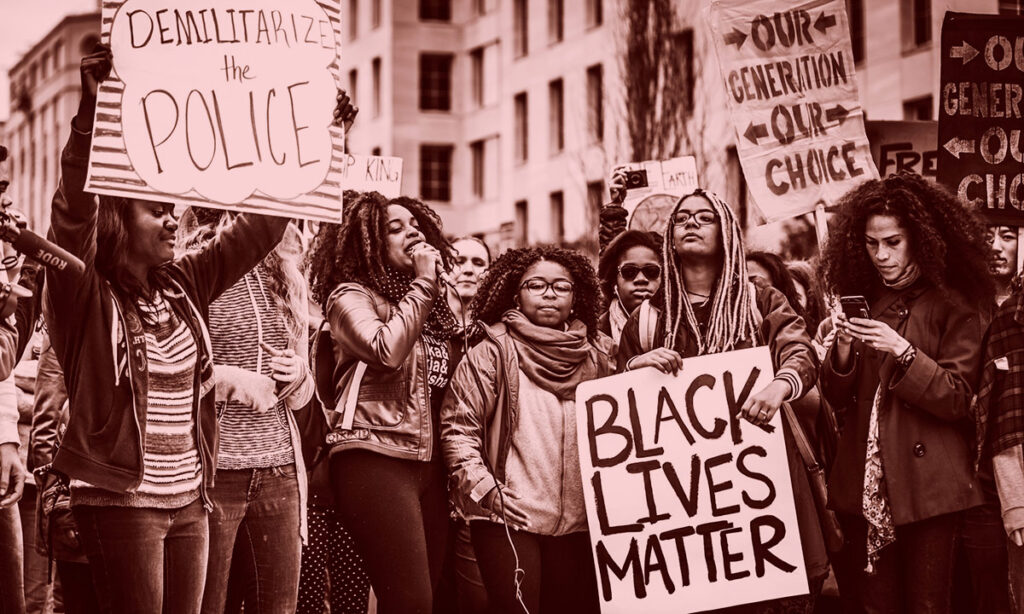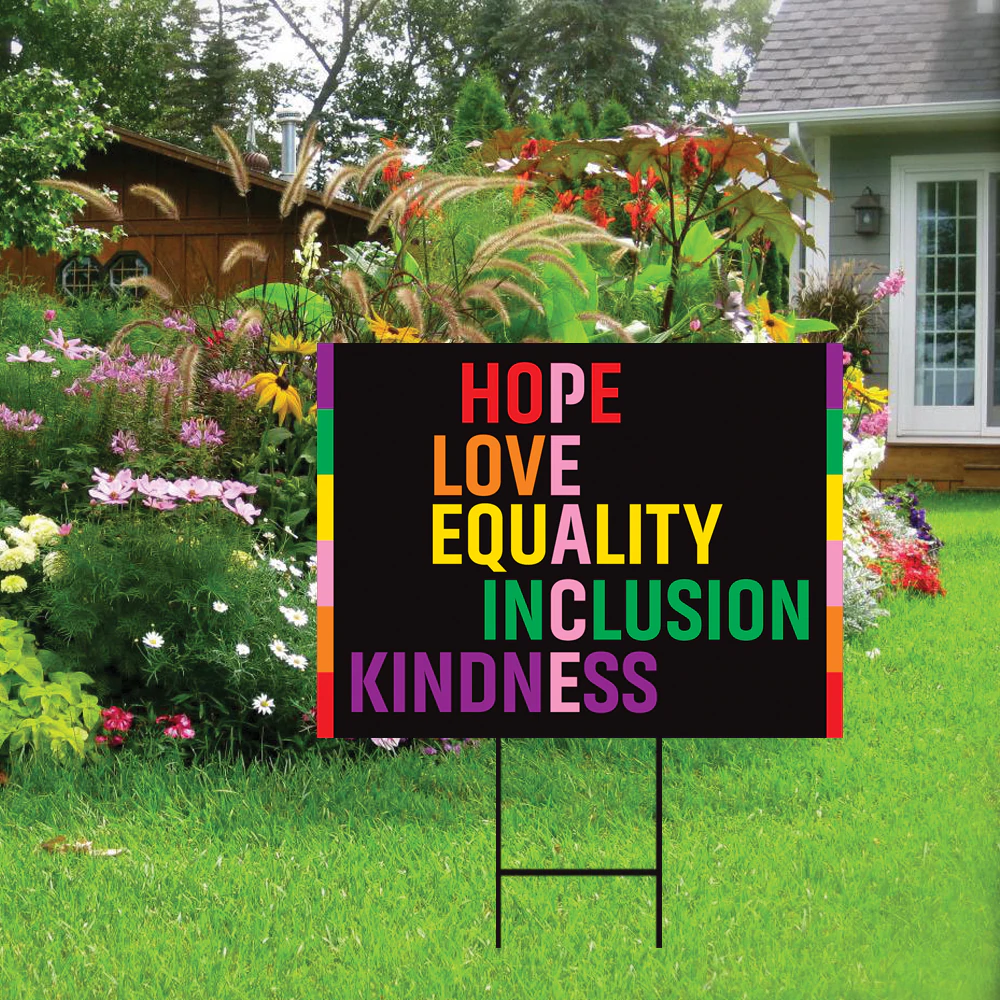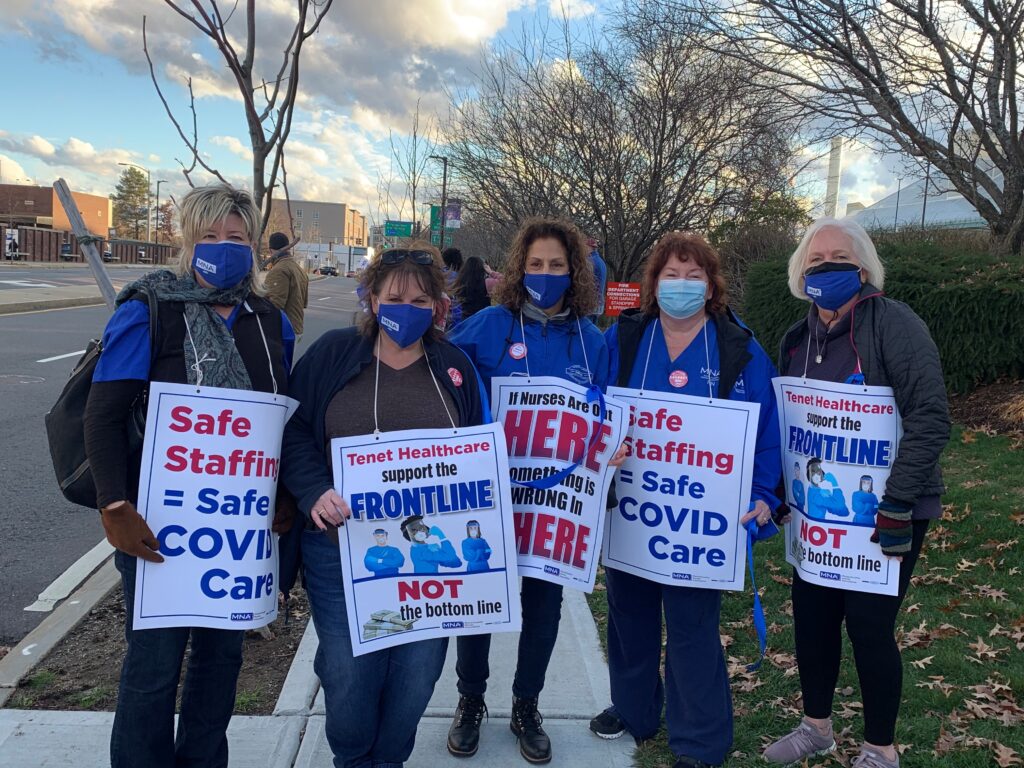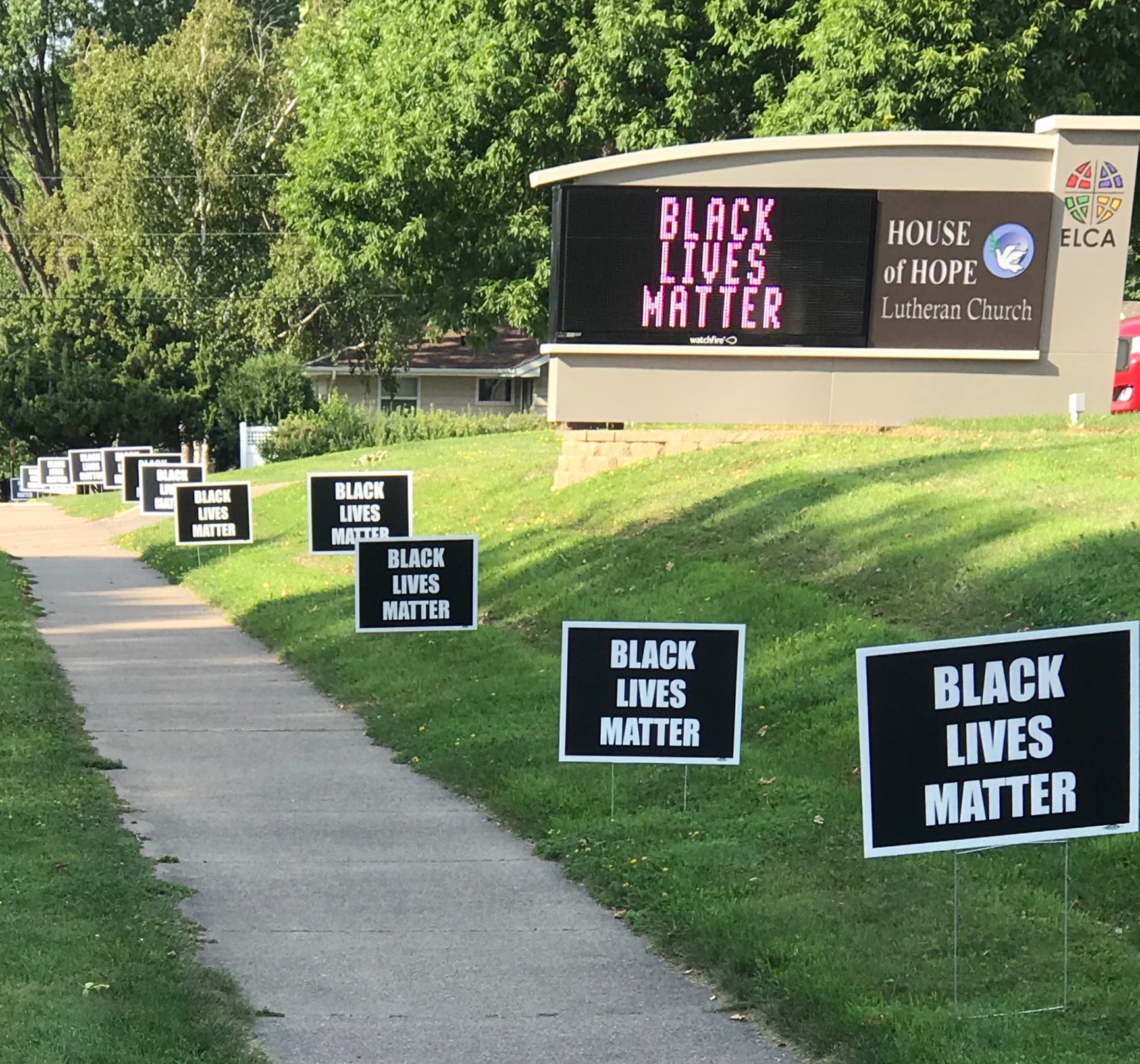Celebrating Black History Month reminds one that, like Dr. Martin Luther King, too many African Americans enter history before their time, felled by those sworn to serve and protect them. Their murders have fueled civil rights uprisings such as swept the country in June 2020, after police blithely took the lives of George Floyd, Breonna Taylor and other Black martyrs. The Black Lives Matter movement these events crystallized may be changing things, but how much it has impacted communities across America is tough to assess, at least for me. I guess you have to be there to know.  BLM incited an international movement; Canadian hip-hop artists take up the cry, June 2020
BLM incited an international movement; Canadian hip-hop artists take up the cry, June 2020
Navigating the streets of my community, an inner suburb of Boston, you’ll find yard signs proclaiming “Black Lives Matter.” Others welcome immigrants or express solidarity with essential workers, while some simply say “Hope” (referring either to Covid or Trump, take your pick). Makes the town look like one big Rainbow Coalition.

Intersectional yard sign, available at Voilà Print
My town has a human rights commission. It also hosts an an anti-racism league, an MLK-Day community breakfast, several minority associations, and a diversity task force focusing on affordable housing. Regardless, just 1.5% of our residents are African-American, much less than neighboring communities *. I’m reminded of this whenever I encounter a Black Lives Matter sign stuck into some well-meaning lawn. A whole lot is being signified but the catchphrase isn’t terribly nuanced. Obviously black lives matter if any do, but what explains why certain parties treat them as expendable?
The Five Whys of The Toyota Way might help to get at the trouble. It’s a method of inquiry that engineering workgroups I’ve been in employ to figure out why something went wrong. You state the situation and then ask “Why?” When a sensible answer comes, ask why again. By the fifth why, the root cause hopefully will emerge.
Try this yourself: If you believe black lives matter, raise your hand and keep it up. If you believe all lives matter (and who doesn’t?), raise your other hand. (Optional: view yourself in a mirror surrendering to truisms.) Now put your hands down and ask why it’s necessary to publicly display such sentiments. If you think it’s a response to endemic racism, you might ask “Why has subjugation, repression, and summary executions of black people persisted since before the founding of the Republic?”
Try answering that and keep digging. I’ll wait while you ponder.
I’ll bet you a beer or a shot that what you eventually come up with has something to do with power elites accumulating wealth at the expense of others. You see where this leads — which tells you why you don’t see the Five Whys applied to social or political unrest: to “Proletarian lives matter” yard signs. Bet another beer you haven’t seen any.
If you want one of those those BLM yard signs and your local human rights commission’s out of them, you can get two of them at black-owned Signs of Justice for $43 plus shipping. If you don’t like that deal, there’s tons more to choose from at Etsy. Forget finding any at blacklivesmatter.com, where Black Lives Matter lives online. Strangely, out of all the hundreds of items of BLM swag for sale there, not one is a yard sign. You can get the affirmation printed on a pillow, top, mug, flag, and of course face mask, but you’ll need to outfit yourself to take the message to the street, asking your fair-skinned self “Does this BLM face mask make me look dorky?”
Alternatively, you can buy $43 worth of groceries to donate to your local food pantry or pizzas for the strike committee at your local Starbucks and cheer on the picketers. Unionizing works. Just ask the nurses at Tenet Healthcare’s St Vincent’s Hospital in Worcester, MA. Their union, Massachusetts Nurses Association , struck for better working conditions last March, and ten month s later the St Vincent nurses ratified a long-sought contract 487-9. Nurses matter. Solidarity matters.
 Nurses on the picket line at St Vincent’s Hospital, Worcester MA. The strike lasted 10 months.
Nurses on the picket line at St Vincent’s Hospital, Worcester MA. The strike lasted 10 months.
It’s worth recalling that Martin Luther King’s last public act was to travel to Memphis to support a bitter, protracted strike by black sanitation workers. In March 1968 he exhorted a crowd of 25,000 (yes, three zeroes) allies of the workers, “You are demonstrating that we can stick together. You are demonstrating that we are all tied in a single garment of destiny, and that if one black person suffers, if one black person is down, we are all down,” and called for a citywide work stoppage .
Within a fortnight he was back, addressing a smaller assembly of striking workers, expressing solidarity, urging courage, and then signing out. The next day he was shot dead at his motel by a white vigilante. Scarcely a week later, in the wake of nationwide protests and riots,
On 8 April [1968], an estimated 42,000 people led by Coretta Scott King, SCLC, and union leaders silently marched through Memphis in honor of King, demanding that [Mayor] Loeb give in to the union’s requests. In front of City Hall, AFSCME pledged to support the workers until “we have justice”. Negotiators finally reached a deal on 16 April, allowing the City Council to recognize the union and guaranteeing a better wage. Although the deal brought the strike to an end, several months later the union had to threaten another strike to press the city to follow through with its commitment. (Stanford University’s King Archives; see above links)
The civil rights movement of the 1950s and 60s spawned anti-discrimination legislation and ordinances, but rights on paper don’t always play out on the ground or in the legal system. Re-energized by recent police atrocities, the movement arose from its 21st-century slumber under the tagline Black Lives Matter to call for justice for minorities and defunding the police. As they did half a century ago, many non-Blacks took up the cause. Thus more community engagement and black yard signs in white suburbs.
But every political action has its reaction. Some white folks looking to stir up trouble lost little time labeling BLM a criminal or communist conspiracy on par with Antifa. Politicians, PACs, pundits, and right-wing media fueled anti-Black resentment, hoping to keep in or sweep into power. Inciting racism pays political dividends.
Call this Antisocial Engineering, a black art practiced by rentiers, red-baiters, and wannabe hegemons at least since Biblical times. Sowing invidious division seems to be perpetually profitable. Reactionary opinion leaders persuade underprivileged whites that the gummint’s gonna give what’s rightfully theirs to undeserving minorities. Follow the money and you’ll realize there’s not equal pay for equal racism: The invidious opportunists who incite racism benefit more than those they incite, time after time.
Signs posted on liberal lawns won’t turn back that toxic red-state tide. Racism can’t be overcome until it ceases to be politically and economically profitable. But as MLK understood, that won’t happen without a broader-based movement that targets economic inequality along with racial disparities. While people of color bear the brunt of low wages and other forms of economic exploitation, Tenet Healthcare wasn’t exploiting nurses at St Vincent Hospital because of their skin color, as far as I know. Recruiting political allies ( watch Sen. Elizabeth Warren addressing the strikers) and thus media attention surely helped, but perseverance and union support got their demands met. And the process was empowering and transformative for many of the strikers, as Marlena Pellegrino, co-chair of the union’s bargaining unit, reflected:
“It’s very hard to absorb what we’ve gone through for nine months, but actually looking back, it changes you as a person. It makes you a better person, makes you a better nurse, makes you a better colleague. We challenged ourselves to pretty much the core of our being.”
I’m with Dr. King: The fight for economic justice is intrinsic to the fight for racial justice. Not just lives, but livelihoods need to matter, and that’s what unions are for.
______
*According to the 2020 US Census, 73% of Belmont’s 27,295 residents are white, 17% Asian, 4% Latino/Hispanic, and 1.5% black. In contrast, the city of Boston (pop. 675,647) is about 50% white and 25% black; Cambridge has 60% white and 11% black; Waltham 72% and 10%, respectively. (See that US Census table here)
You can find this and previous Perfidy Press Provocations in the Perfidy Press newsletter archive. If you see any you like, please consider forwarding them to people who might in turn subscribe, and thanks.


[…] On Making Black and Other Lives Materially Matter (newsletter)February 16, 2022Celebrating Black History Month reminds one that, like […] […]